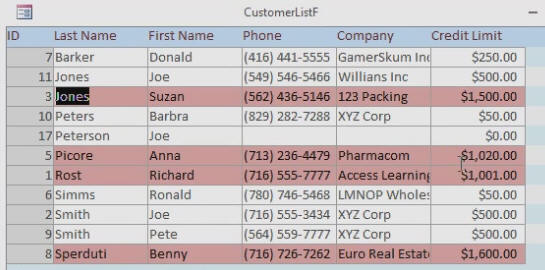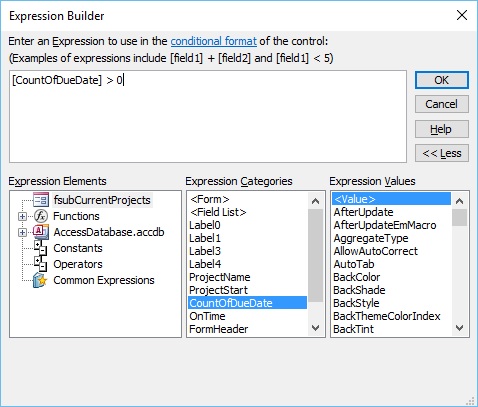Conditionally Format Microsoft Access Report Rows:

Microsoft Access Conditional Formatting Examples Sentences
Microsoft Access 2000 and above contains options to use conditional formatting in reports and forms.
Conditionally Format Microsoft Access Report Rows: Microsoft Access 2000 and above contains options to use conditional formatting in reports and forms. If a control on a form or report contains values that you want to monitor, apply conditional formatting to the control to make it easier to spot. I am using MS Access 2010. I need to set conditional formatting for two textboxes on a continuous form. Download encore cs6 for windows. I know that older versions of MS Access allowed only 3 conditions on a textbox, but I know that I can get more conditions in Access 2010. My current application has 4 conditions using the user interface.
If a control on a form or report contains values that you want to monitor, apply conditional formatting to the control to make it easier to spot. For example, you can set conditional formatting so that if an employee's salary exceeds £100,000 the field's background turns red. Or you can set formatting so that text in the City field is green and italic if a customer resides in London.
You may want to highlight the whole row in a Microsoft Access report if the data in that row meets a certain criteria as the example will show.
If we use a membership report as the example, we would like to format rows differently where the membership is not currently active.
The record contains a checkbox called ysnActiveMember (If checked the membership is currently active, if not the membership is inactive and would need renewing). The design of the report is shown below:
Google chrome 24.0.1312.14 betaumair sajid minhas.
The report in design view, showing the detail section and the Active checkbox

To conditionally format the controls in the Detail section of the report, we need to select all of these (excluding the Active checkbox) and then open Format » Conditional Formatting.
We will set the Condition to - Expression Is: [ysnActiveMember]=False
This will allow us to conditionally format any records in the detail section where the Active field is unchecked (or the membership needs to be renewed). We can then set formats to show the records - I have set the controls to: Text Colour = Red, Weight = Bold as shown in the example below:
Showing the formatting set up in the Conditional Formatting dialog
Now when we run the report, it is easy to pick out any records that have met the conditions that you have applied:
The finished report showing the conditionally formatted records
Using conditional formatting in Microsoft Access 2000, XP or 2003 allows you to set multiple conditions in your database forms and reports.
Conditionally Formatting Microsoft Access Form Data
Springsteen 1978 tour complete download torrent pirate bay. Most Microsoft Access database applications will contain user forms, both for data entry and for viewing the data. These database forms are what most of your users will see and work with every day.
Whilst most of the form design is intended to allow the user to enter the correct information into the correct database tables, sometimes, you may wish to draw your user's attention to a particular control or value on the form. This article will address this topic, and will deal with changing the format of a form control based upon a condition that you set.
As database users can make mistakes, and this number of errors can increase when the user is distracted or hurried, anything that you as the form designer can do to reduce the errors or draw the users attention to important information will help.
Conditional Formatting In Access Table
Changing the display of a form, based upon the data that the user enters allows you to provide immediate feedback to the user about the data that they just entered. An example of this would be if we changed the associated text to Red in a field to indicate that the data entered was unacceptable for that field.
Conditional Formatting - an Access tool that enables you to change the formatting of a control based upon conditions that you have defined. Microsoft Access allows you to set up to three conditions. You can use conditional formatting in Microsoft Access forms and reports.
How To Change The Display Of Data Conditionally - Apply Conditional Formatting to a Control
- Select the Control
- Choose Format » Conditional Formatting
- Enter the condition(s) under which the formatting is to be applied
- Select the formatting that you want to apply
- Click OK
Suppose we have a Microsoft Access form that displays information to Products In Stock and Reorder Levels for these Products. It would be beneficial to highlight any records where the Units In Stock had fallen below the Reorder Level for that item.

We can do this be using an expression as the condition in the conditional formatting dialog box.
Below we can see our Product form, that details the Products in Stock and their ReOrder Levels:
We would like to highlight when a Product Reorder Level is greater than the amount of Units In Stock (meaning that we need to Reorder that Product. To do this we need to:

Microsoft Access Conditional Formatting Examples Sentences
Microsoft Access 2000 and above contains options to use conditional formatting in reports and forms.
Conditionally Format Microsoft Access Report Rows: Microsoft Access 2000 and above contains options to use conditional formatting in reports and forms. If a control on a form or report contains values that you want to monitor, apply conditional formatting to the control to make it easier to spot. I am using MS Access 2010. I need to set conditional formatting for two textboxes on a continuous form. Download encore cs6 for windows. I know that older versions of MS Access allowed only 3 conditions on a textbox, but I know that I can get more conditions in Access 2010. My current application has 4 conditions using the user interface.
If a control on a form or report contains values that you want to monitor, apply conditional formatting to the control to make it easier to spot. For example, you can set conditional formatting so that if an employee's salary exceeds £100,000 the field's background turns red. Or you can set formatting so that text in the City field is green and italic if a customer resides in London.
You may want to highlight the whole row in a Microsoft Access report if the data in that row meets a certain criteria as the example will show.
If we use a membership report as the example, we would like to format rows differently where the membership is not currently active.
The record contains a checkbox called ysnActiveMember (If checked the membership is currently active, if not the membership is inactive and would need renewing). The design of the report is shown below:
Google chrome 24.0.1312.14 betaumair sajid minhas.
The report in design view, showing the detail section and the Active checkbox
To conditionally format the controls in the Detail section of the report, we need to select all of these (excluding the Active checkbox) and then open Format » Conditional Formatting.
We will set the Condition to - Expression Is: [ysnActiveMember]=False
This will allow us to conditionally format any records in the detail section where the Active field is unchecked (or the membership needs to be renewed). We can then set formats to show the records - I have set the controls to: Text Colour = Red, Weight = Bold as shown in the example below:
Showing the formatting set up in the Conditional Formatting dialog
Now when we run the report, it is easy to pick out any records that have met the conditions that you have applied:
The finished report showing the conditionally formatted records
Using conditional formatting in Microsoft Access 2000, XP or 2003 allows you to set multiple conditions in your database forms and reports.
Conditionally Formatting Microsoft Access Form Data
Springsteen 1978 tour complete download torrent pirate bay. Most Microsoft Access database applications will contain user forms, both for data entry and for viewing the data. These database forms are what most of your users will see and work with every day.
Whilst most of the form design is intended to allow the user to enter the correct information into the correct database tables, sometimes, you may wish to draw your user's attention to a particular control or value on the form. This article will address this topic, and will deal with changing the format of a form control based upon a condition that you set.
As database users can make mistakes, and this number of errors can increase when the user is distracted or hurried, anything that you as the form designer can do to reduce the errors or draw the users attention to important information will help.
Conditional Formatting In Access Table
Changing the display of a form, based upon the data that the user enters allows you to provide immediate feedback to the user about the data that they just entered. An example of this would be if we changed the associated text to Red in a field to indicate that the data entered was unacceptable for that field.
Conditional Formatting - an Access tool that enables you to change the formatting of a control based upon conditions that you have defined. Microsoft Access allows you to set up to three conditions. You can use conditional formatting in Microsoft Access forms and reports.
How To Change The Display Of Data Conditionally - Apply Conditional Formatting to a Control
- Select the Control
- Choose Format » Conditional Formatting
- Enter the condition(s) under which the formatting is to be applied
- Select the formatting that you want to apply
- Click OK
Suppose we have a Microsoft Access form that displays information to Products In Stock and Reorder Levels for these Products. It would be beneficial to highlight any records where the Units In Stock had fallen below the Reorder Level for that item.
We can do this be using an expression as the condition in the conditional formatting dialog box.
Below we can see our Product form, that details the Products in Stock and their ReOrder Levels:
We would like to highlight when a Product Reorder Level is greater than the amount of Units In Stock (meaning that we need to Reorder that Product. To do this we need to:
- In form design view, select the Reorder Level Control
- Choose Format » Conditional Formatting
- For Condition 1, select 'Expression Is' and enter the expression. In this example, we use [intReorderLevel]>[intUnitsInStock], which is checking whether the Reorder Level is greater than the amount of Units In Stock
- Choose the format to apply. In our example, we have applied a Red backcolour to the text box
The Conditional Formatting applied to the form.
When we view the form data, and a record meets the above condition, we can see the formatting applied as shown below:
Showing the formatting when a record meets the conditions
